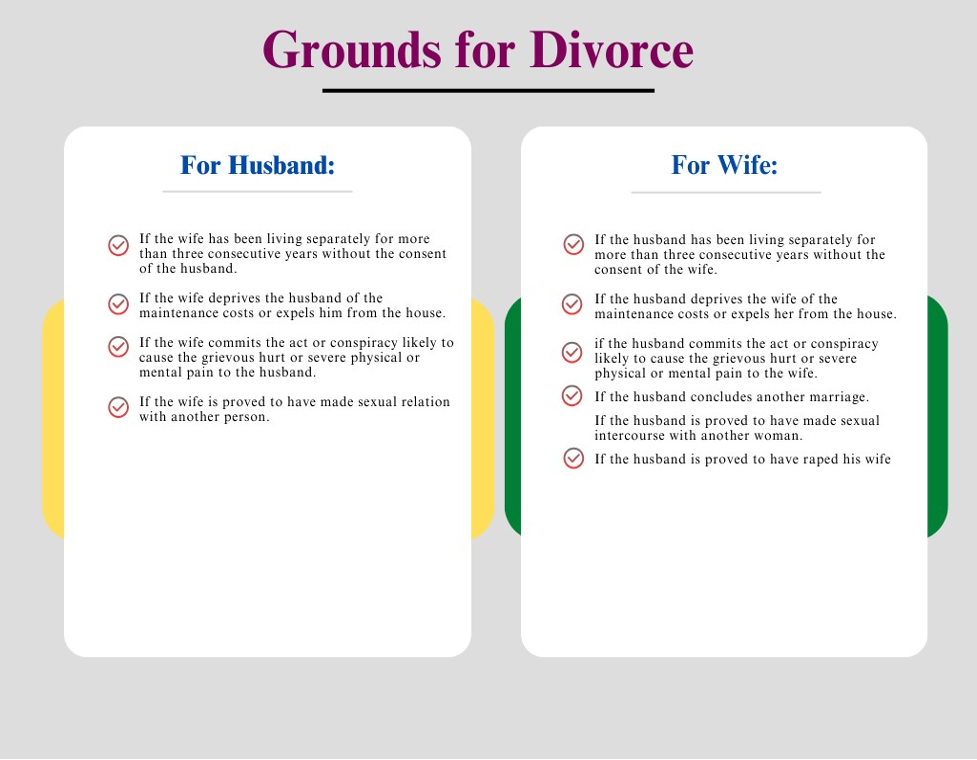Mutual Consent Divorce Process of Nepali and Foreigner
(This article explains the process of Husband and Wife Mutual Consent Divorce in Nepal)
Introduction:
In another word, divorce means legal termination and the dissolution of marriage between legally married spouse through court. For legal validation, a divorce must be concluded only in the court.
Governing Laws for divorce in Nepal
- Muluki Civil Code, 2074
- Muluki Civil Procedure Rules, 2075
Who can file divorce case in Nepal
- Only husband or wife can file for divorce in Nepal
- If the husband or wife cannot be physically present in the court, the the assigned Power of Attorney (POA) who can act on behalf of them may file for divorce.
Where can husband or wife file for divorce
The husband or wife who wants to file for divorce have to follow the legal jurisdiction as to where to file for divorce or what would be the authority for divorce filing;
- District Court of Husband or Wife of their permanent address.
- District Court of temporary address of husband or wife (here, temporary residence recommendation document of temporary residing ward is needed)
- In case of property with divorce case, in the District Court where the property is located
Legal grounds for divorce
In context of Nepal, spouses or married couple need to provide some grounds or reasons for divorce in their petition while filing for divorce. Basically, as per new National Civil Code of Nepal, 2074, there are certain conditions for both husband and wife to file divorce petition in the court;

6. Forms of Divorce
Basically, as per Nepalese law, divorce is conducted in mainly two ways:
- Mutual consent divorce
- Unconsented divorce
1.1. Meaning of Mutual Consent Divorce
- Dissolution of marriage between husband and wife at any time from their mutual understanding (concluded only in court) that the marriage has broken down and they are willing to separate by mutual agreement.
- In this type of marriage both the husband and wife have understanding on various aspects such as division of property, alimony, child custody and others and they act accordingly upon reaching the agreement.
Mutual Consent divorce in case of one party being Nepali citizen and other being foreigner
- Required Documents:
| S.N | Required Documents for Mutual Consent Divorce |
| 1. | Citizenship copy of the Nepali citizen and passport copy of the foreigner. |
| 2. | Marriage registration certificate (if not then, marriage photos will work) |
| 3. | Child birth certificate (if having any child) |
| 4. | Passport size photos (2 copies each) of both husband and wife and of the assigned POA too. |
| 5. | Temporary residence document from the ward office (if Nepali citizen be the resident of any other district other than the citizenship issuance district) |
| 6. | If foreigner is in Nepal at the time of divorce, then, must appear in the court otherwise, Authorized Power of Attorney (POA)(”Adhikrit wareshnama”) is required that must be notarized by the Notary lawyer in the foreign country he/she is residing. |
Documents Required for mutual consent divorce between one party being Nepali citizen and other foreigner:
Required Documents:
S.N Required Documents for Mutual Consent Divorce 1. Citizenship copy of the Nepali citizen and passport copy of the foreigner. 2. Marriage registration certificate (if not then, marriage photos will work) 3. Child birth certificate (if having any child) 4. Passport size photos (2 copies each) of both husband and wife and of the assigned POA too. 5. Temporary residence document from the ward office (if Nepali citizen be the resident of any other district other than the citizenship issuance district) 6. If foreigner is in Nepal at the time of divorce, then, must appear in the court otherwise, Authorized Power of Attorney (POA)(”Adhikrit wareshnama”) is required that must be notarized by the Notary lawyer in the foreign country. Court Process of Mutual Consented Divorce between Nepali and Foreigner:
Process of Divorce (Mutual Consent) |
| – 2 days Court Process 1st day court process: Step 1: Preparation of petition by one party who wants to file for divorce (either by husband or wife) Step 2: Filing of the divorce petition in the concerned court mentioning the grounds for divorce. (if the foreigner wants to file for divorce, or reply on divorce, Power of Attorney (POA) we prepare must be signed and notarized by notary Lawyer of his residing country and send us the physical copy than the assigned POA shall file for divorce on his/her behalf) Step 3: After the court examines all the documents and the petition and if it finds it under jurisdiction and fullfillment of all the required documents, registers the petition and provides the next day’s date for the final process of divorce. 2nd day court Process: Step 4: Preparation of respondant’s reply by another party (referred as “pratiuttar”) and other mutual application as well mutual consent document(“milapatra”) by both the parties. Step 5: Physical presence of one party (Nepali citizen) and other assigned POA along with their original Identity card, citizenship) in the court. Step 6: Other party shall give the reply of the petition as well both the parties shall submit mutual application and mutual consent document stating their consent for divorce. Step 7: And after the complete inquiry of the document by the court and after having registered such document, the file is taken before the Judge Step 8: If it seems to have followed the complete procedure along with other necessary required documents and if the Judge finds it appropriate than the divorce is concluded between husband and wife. Step 9: Issuance of divorce certificate. |
Please contact us today itself if you are in search of lawyers for guardianship process in Nepal on +9779841933745 or email info@lawinpartners.com
Disclaimer: All contains available here are for general information purposes. A proper legal solution always depends on your particular circumstances thus seek advice from an attorney who can provide assurances of the information contained herein and interpretation of it. All liability with respect to actions taken on the basis of the site’s information is hereby expressly disclaimed.

